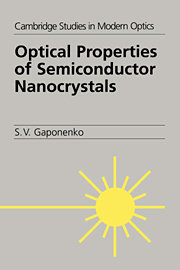Book contents
- Frontmatter
- Contents
- Preface
- 1 Electron states in crystal
- 2 Electron states in an ideal nanocrystal
- 3 Growth of nanocrystals
- 4 General properties of spectrally inhomogeneous media
- 5 Absorption and emission of light by semiconductor nanocrystals
- 6 Resonant optical nonlinearities and related many-body effects
- 7 Interface effects
- 8 Spatially organized ensembles of nanocrystals
- References
- Index
7 - Interface effects
Published online by Cambridge University Press: 09 October 2009
- Frontmatter
- Contents
- Preface
- 1 Electron states in crystal
- 2 Electron states in an ideal nanocrystal
- 3 Growth of nanocrystals
- 4 General properties of spectrally inhomogeneous media
- 5 Absorption and emission of light by semiconductor nanocrystals
- 6 Resonant optical nonlinearities and related many-body effects
- 7 Interface effects
- 8 Spatially organized ensembles of nanocrystals
- References
- Index
Summary
In quasi-zero-dimensional structures under optical excitation there are, along with reversible processes that decay over the recombination time of electron-hole pairs, processes that result in a persistent change in the optical properties. These processes are controlled by the integral dose of the absorbed radiation rather than radiation intensity. Numerous examples of similar behavior can be found in photophysics and photochemistry of molecular structures. Similar to molecular structures, semiconductor nanocrystals embedded in a matrix or precipitated in a solution exhibit a variety of guest-host effects. Some of the phenomena related to the photo-induced modifications in absorption and/or emission features will be the subject of the present chapter. The main attention will be given to laser annealing, photodarkening, persistent spectral hole-burning, and photochemical reactions resulting in permanent spectral hole-burning. Finally, we consider the intercrystallite migration of carriers and its effect on luminescence kinetics.
Laser annealing, photodarkening, and photodegradation
Semiconductor-doped glasses exposed to prolonged illumination by laser light of a wavelength corresponding to resonant absorption by nanocrystals were found to exhibit systematically a number of photo-induced modifications. These include, first of all, a sharp decrease in the intrinsic edge luminescence versus impurity and defect related emission. Second, the lifetime of electron-hole pairs decreases by several orders of magnitude and reaches 10−11 s. Finally, additional structureless absorption with a coefficient on the order of 1 cm−1 appears in a wide spectral interval. The initial properties of the samples can sometimes be restored by heating to temperatures of 400–500°C.
Information
- Type
- Chapter
- Information
- Optical Properties of Semiconductor Nanocrystals , pp. 179 - 202Publisher: Cambridge University PressPrint publication year: 1998
